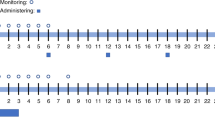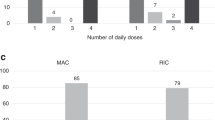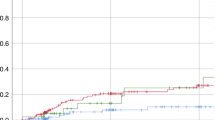Abstract
Intravenous BU divided four times daily (q6 h) has been shown to be safe and effective in pediatric allo-SCT recipients. Though less frequent dosing is desirable, pharmacokinetic (PK) data on twice daily (q12 h) i.v. BU administration in pediatric allo-SCT recipients is limited. We prospectively examined the PK results in a cohort of pediatric allo-SCT recipients receiving i.v. BU q12 h as part of conditioning before allo-SCT. BU levels were obtained after the first dose of conditioning. PK parameter analysis (n=49) yielded the following 95% confidence intervals (CI95): weight-normalized volume of distribution: 0.65–0.73 L/kg; t1/2: 122–147 min; weight-normalized clearance (CLn): 3.4–4.3 mL/min/kg; and area under the curve: 1835–2180 mmol × min/L. From these results, a steady state concentration was calculated with CI95 between 628–746 ng/mL. Comparison between recipients ⩽4 vs >4 years old revealed significant differences in t1/2 (mean: 115 vs 146 min, P=0.008) and CLn (mean: 4.4 vs 3.5 mL/min/kg, P=0.038). Intravenous BU q12 h had a comparable PK to i.v. BU q6 h PK seen in the literature, and in pediatric allo-SCT recipients, is a feasible, attractive alternative to i.v. q6h dosing.
This is a preview of subscription content, access via your institution
Access options
Subscribe to this journal
Receive 12 print issues and online access
$259.00 per year
only $21.58 per issue
Buy this article
- Purchase on Springer Link
- Instant access to full article PDF
Prices may be subject to local taxes which are calculated during checkout




Similar content being viewed by others
References
Ciurea SO, Andersson BS . Busulfan in hematopoietic stem cell transplantation. Biol Blood Marrow Transplant 2009; 15: 523–536.
Hoy SM, Lyseng-Williamson KA . Intravenous busulfan: in the conditioning treatment of pediatric patients prior to hematopoietic stem cell transplantation. Paediatr Drugs 2007; 9: 271–278.
Dix SP, Wingard JR, Mullins RE, Jerkunica I, Davidson TG, Gilmore CE et al. Association of busulfan area under the curve with veno-occlusive disease following BMT. Bone Marrow Transplant 1996; 17: 225–230.
Vassal G, Deroussent A, Hartmann O, Challine D, Benhamou E, Valteau-Couanet D et al. Dose-dependent neurotoxicity of high-dose busulfan in children: a clinical and pharmacological study. Cancer Res 1990; 50: 6203–6207.
Booth BP, Rahman A, Dagher R, Griebel D, Lennon S, Fuller D et al. Population pharmacokinetic-based dosing of intravenous busulfan in pediatric patients. J Clin Pharmacol 2007; 47: 101–111.
Dalle JH, Wall D, Theoret Y, Duval M, Shaw L, Larocque D et al. Intravenous busulfan for allogeneic hematopoietic stem cell transplantation in infants: clinical and pharmacokinetic results. Bone Marrow Transplant 2003; 32: 647–651.
Michel G, Valteau-Couanet D, Gentet JC, Esperou H, Socie G, Mechinaud F et al. Weight-based strategy of dose administration in children using intravenous busulfan: clinical and pharmacokinetic results. Pediatr Blood Cancer 2012; 58: 90–97.
Nguyen L, Fuller D, Lennon S, Leger F, Puozzo CIV . busulfan in pediatrics: a novel dosing to improve safety/efficacy for hematopoietic progenitor cell transplantation recipients. Bone Marrow Transplant 2004; 33: 979–987.
Tran H, Petropoulos D, Worth L, Mullen CA, Madden T, Andersson B et al. Pharmacokinetics and individualized dose adjustment of intravenous busulfan in children with advanced hematologic malignancies undergoing allogeneic stem cell transplantation. Biol Blood Marrow Transplant 2004; 10: 805–812.
Wall DA, Chan KW, Nieder ML, Hayashi RJ, Yeager AM, Kadota R et al. Safety, efficacy, and pharmacokinetics of intravenous busulfan in children undergoing allogeneic hematopoietic stem cell transplantation. Pediatr Blood Cancer 2010; 54: 291–298.
Mellgren K, Nilsson C, Fasth A, Abrahamsson J, Winiarski J, Ringden O et al. Safe administration of oral BU twice daily during conditioning for stem cell transplantation in a paediatric population: a comparative study between the standard 4-dose and a 2-dose regimen. Bone Marrow Transplant 2008; 41: 621–625.
LeGall J, Milone M, Waxman I, Shaw L, Harrison L, Duffy D et al. IV Busulfan administered q12 vs q6hrs during conditioning of pediatric allogeneic stem cell transplant (AlloSCT) recipients have comparable pharmacokinetics and significant reduction in nursing/pharmacist costs. Biol Blood Marrow Transplant 2011; 17: S258.
Fernandez HF, Tran HT, Albrecht F, Lennon S, Caldera H, Goodman MS . Evaluation of safety and pharmacokinetics of administering intravenous busulfan in a twice-daily or daily schedule to patients with advanced hematologic malignant disease undergoing stem cell transplantation. Biol Blood Marrow Transplant 2002; 8: 486–492.
Geyer MB, Jacobson JS, Freedman J, George D, Moore V, van de Ven C et al. A comparison of immune reconstitution and graft-versus-host disease following myeloablative conditioning versus reduced toxicity conditioning and umbilical cord blood transplantation in paediatric recipients. Br J Haematol 2011; 155: 218–234.
Korecka M, Shaw LM . Review of the newest HPLC methods with mass spectrometry detection for determination of immunosuppressive drugs in clinical practice. Ann Transplant 2009; 14: 61–72.
Lai WK, Pang CP, Law LK, Wong R, Li CK, Yuen PM . Routine analysis of plasma busulfan by gas chromatography-mass fragmentography. Clin Chem 1998; 44: 2506–2510.
Bhatia M, Militano O, Jin Z, Figurski M, Shaw L, Moore V et al. An age-dependent pharmacokinetic study of intravenous and oral mycophenolate mofetil in combination with tacrolimus for GVHD prophylaxis in pediatric allogeneic stem cell transplantation recipients. Biol Blood Marrow Transplant 2010; 16: 333–343.
Osunkwo I, Bessmertny O, Harrison L, Cheung YK, Van de Ven C, del Toro G et al. A pilot study of tacrolimus and mycophenolate mofetil graft-versus-host disease prophylaxis in childhood and adolescent allogeneic stem cell transplant recipients. Biol Blood Marrow Transplant 2004; 10: 246–258.
Glucksberg H, Storb R, Fefer A, Buckner CD, Neiman PE, Clift RA et al. Clinical manifestations of graft-versus-host disease in human recipients of marrow from HL-A-matched sibling donors. Transplantation 1974; 18: 295–304.
Waxman IM, Militano O, Baldinger L, Roman E, Qualter E, Morris E et al. Sequential administration of sargramostim and filgrastim in pediatric allogeneic stem cell transplantation recipients undergoing myeloablative conditioning. Pediatr Transplant 2009; 13: 464–474.
Roman E, Osunkwo I, Militano O, Cooney E, van de Ven C, Cairo MS . Liposomal amphotericin B prophylaxis of invasive mold infections in children post allogeneic stem cell transplantation. Pediatr Blood Cancer 2008; 50: 325–330.
Shereck EB, Cooney E, van de Ven C, Della-Lotta P, Cairo MS . A pilot phase II study of alternate day ganciclovir and foscarnet in preventing cytomegalovirus (CMV) infections in at-risk pediatric and adolescent allogeneic stem cell transplant recipients. Pediatr Blood Cancer 2007; 49: 306–312.
Styczynski J, Tallamy B, Waxman I, van de Ven C, Milone MC, Shaw LM et al. A pilot study of reduced toxicity conditioning with BU, fludarabine and alemtuzumab before the allogeneic hematopoietic SCT in children and adolescents. Bone Marrow Transplant 2011; 46: 790–799.
McDonald GB, Hinds MS, Fisher LD, Schoch HG, Wolford JL, Banaji M et al. Veno-occlusive disease of the liver and multiorgan failure after bone marrow transplantation: a cohort study of 355 patients. Ann Intern Med 1993; 118: 255–267.
Zwaveling J, den Hartigh J, Lankester AC, Guchelaar HJ, Egeler RM, Bredius RG . Once-daily intravenous busulfan in children prior to stem cell transplantation: study of pharmacokinetics and early clinical outcomes. Anticancer Drugs 2006; 17: 1099–1105.
Kletzel M, Jacobsohn D, Duerst R . Pharmacokinetics of a test dose of intravenous busulfan guide dose modifications to achieve an optimal area under the curve of a single daily dose of intravenous busulfan in children undergoing a reduced-intensity conditioning regimen with hematopoietic stem cell transplantation. Biol Blood Marrow Transplant 2006; 12: 472–479.
Kim AH, Tse JC, Ikeda A, Moore TB . Evaluating pharmacokinetics and pharmacodynamics of intravenous busulfan in pediatric patients receiving bone marrow transplantation. Pediatr Transplant 2009; 13: 971–976.
Simon A, Fleischack G, Hasan C, Bode U, Engelhart S, Kramer MH . Surveillance for nosocomial and central line-related infections among pediatric hematology-oncology patients. Infect Control Hosp Epidemiol 2000; 21: 592–596.
Horwitz ME, Morris A, Gasparetto C, Sullivan K, Long G, Chute J et al. Myeloablative intravenous busulfan/fludarabine conditioning does not facilitate reliable engraftment of dual umbilical cord blood grafts in adult recipients. Biol Blood Marrow Transplant 2008; 14: 591–594.
Acknowledgements
We would like to thank the patients and families that participated in these studies and the laboratory staff at the clinical toxicology laboratory at HUP.
This work was supported in part by grants from the Pediatric Cancer Research Foundation, National Institute of Arthritis and Musculoskeletal and Skin Diseases (R21 AR49330; MSC), Marisa Fund, Sonia Scaramella Fund, Paul Luisi Foundation, Brittany Barron Fund and the Doris Duke Charitable Foundation.
Author information
Authors and Affiliations
Corresponding author
Ethics declarations
Competing interests
IMW and MBB currently work for Bristol Myers Squibb. All other authors declare no conflict of interest.
Additional information
Presented in part at the American Society of Blood and Marrow Transplantation (ASBMT), February, 2011, Honolulu, Hawaii
Rights and permissions
About this article
Cite this article
Le Gall, J., Milone, M., Waxman, I. et al. The pharmacokinetics and safety of twice daily i.v. BU during conditioning in pediatric allo-SCT recipients. Bone Marrow Transplant 48, 19–25 (2013). https://doi.org/10.1038/bmt.2012.105
Received:
Revised:
Accepted:
Published:
Issue Date:
DOI: https://doi.org/10.1038/bmt.2012.105
Keywords
This article is cited by
-
Review of the Pharmacokinetics and Pharmacodynamics of Intravenous Busulfan in Paediatric Patients
Clinical Pharmacokinetics (2021)
-
Reduced toxicity, myeloablative conditioning with BU, fludarabine, alemtuzumab and SCT from sibling donors in children with sickle cell disease
Bone Marrow Transplantation (2014)
-
New frontiers in pediatric Allo-SCT
Bone Marrow Transplantation (2014)



